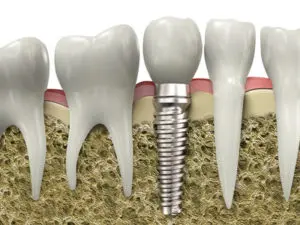Tooth Loss Can Have Far-reaching Effects on Your Dental Health


First of all, the crown is not the only portion of the tooth that is lost. The underlying root structure performs a number of important functions, although we often take this part of the tooth for granted because we cannot see it when we smile.
For example, the root secures the jawbone in the vicinity. When the root is not present to perform that role, the bone erodes. This can introduce the risk of further tooth loss.
Dental implants replace the root of the tooth because the surrounding bone forms a bond with the titanium implant after the oral surgeon inserts it into the jaw.
Because dental implants mimic tooth roots, they preserve the bone at the implant site. With other tooth replacement methods, like bridges or dentures, only the crown is replaced and the bone will erode, with negative effects on your oral health.
Dental implants also help to maintain most of your chewing function, which is also compromised following tooth loss. The structural similarities between the implant and the biological tooth allow the implant to withstand significant chewing forces that are stronger than those tolerated by a denture or a bridge.
It’s also easier to keep the gum line clean and minimize bacteria for patients who choose dental implants, which stand alone without support from surrounding teeth. Unlike a dental bridge, for example, dental implants have no components that restrict access to the gum line. Patients with dental implants can brush and floss the implants just like they do with their natural teeth.
Patients who experience tooth loss can experience various negative effects on their oral health. A tooth replacement option that replicates the structure of a biological tooth, like dental implants, can mitigate many of those effects. Talk to an oral surgeon at Great River Oral & Maxillofacial Surgery about this intervention.